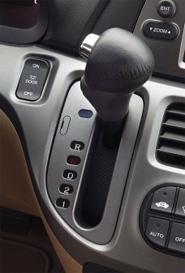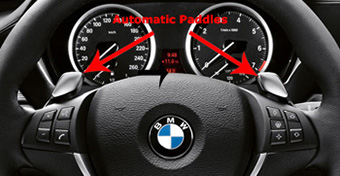Traditionally, driving an automatic car has never been as popular as driving a manual car. This has been for three reasons:
However, automatic transmissions are becoming increasingly more sophisticated and economical. In fact, the evolution of the automatic transmission is happening at such a pace they are likely to soon become the norm.
In a car with manual transmission the driver decides when to change gear and does so by pressing the clutch pedal down and then selecting the desired gear by moving the gear stick.
In an automatic car the gear change is made automatically, hence there is no clutch or gear stick. When the transmission is put into Drive (D) the car will automatically select the correct gear according to the load on the engine and the road speed. Usually, an automatic will change to a higher gear as the road speed increase, and to a lower gear as it falls.


An automatic transmission will also change down to a lower gear when going uphill, as the load on the engine increases.
The Gear Selector
Nearly all automatic have a gear selector, which will usually include:Why, you may ask, are first and second gear available for the driver to select, this is an automatic after all. Well, sometimes, the driver of an automatic will need to override the automatic system and select a low gear, i.e. when going down a steep hill. In such a situation the automatic transmission will try and change into a higher gear, however, for safety reasons, it is better to drive down a steep hill in a low gear, hence the manual override.
Semi-automatic transmissions are becoming increasingly popular. These have a manual gearshift, giving the driver control over gear selection, but no clutch pedal - the clutch is operated automatically every time a new gear is selected.
Automatic and semi-automatic systems differ from car to car and you should always read the manual carefully before driving one. However, this general advice will prove useful and relevant to all systems:
Creep
Automatics are deliberately designed to 'creep' forward without any pressure being applied to the accelerator pedal. Because of this, when stationary with the engine ticking over, you must engage the brake pedal or the handbrake.
Kick-down
When driving an automatic, if you need to suddenly accelerate more quickly, for example when overtaking another vehicle, you can use the kick-down device. This feature allows you to over-ride the automatic selection of gears and forces the transmission to stay in lower gears for longer. This gives you a higher degree of acceleration than normal.
To activate kick-down you simply press down hard on the accelerator pedal and keep it fully pressed down until you reach your desired speed. When you reach this speed, ease back off the accelerator and the car will automatically return to normal drive and select the most appropriate gear.
Slowing Down and Stopping
This is easier in an automatic than a manual car. However, you must remember that an automatic gear box does not respond as quickly as manual to easing off the gas, so the ability of the engine brake to slow the car is severely reduced.
To slow down, transfer your right foot from the accelerator pedal to the brake pedal. Because of the reduced engine braking, you must brake sooner and more progressively than in a manual car. The transmission will automatically work its way down the gears as you slow down, so you are always in the correct gear. This is a great help at junctions and any other situation where you need to slow down, as it allows you to focus on observations and safety rather than changing gear.
When the car comes to a stop, to avoid creep, you must keep your foot on the brake, and remember, the car will not stall, even if you stop suddenly.
Parking and Waiting
As a rule, you should always apply the handbrake whenever waiting in traffic. If, you only need to pause, you should apply the foot brake.
When parking, you should apply the handbrake and then select the Park position on the gear selector, all before releasing the foot brake. Just before you drive away you should apply the foot brake, release the hand brake and then select Drive.
Hill Starts
On steep hills creep may be insufficient to get you moving after you release the foot brake. Some automatics have a feature that will prevent roll back, but if yours doesn't, you should use the following routine.
Driving Downhill
To help control the speed of the car, and to save you having to brake excessively, when driving down hill you should select one of the locked gear positions, either 1, 2 or 3. This will keep the car in the selected low gear and stop the automatic transmission selecting a high gear, which will help increase your speed.
Cornering
Automatics sometimes change up as you approach a corner due to reduced pressure on the accelerator, which could cause you to take the corner faster than you had intended. To avoid this, slow down before you reach the corner then accelerate gently as you start to turn. This will encourage the automatic gearbox to select a lower gear for the corner.
On roads with a series of bends, you can select the 3rd locked gear position to prevent the gearbox from selecting higher gears.
Driving In Snow and Ice
To help avoid wheel-spin when driving on slippery roads, it helps to select a higher gear. Some automatics have a setting for such conditions, which you can select manually, but if yours doesn't you can select locked positions 2 or 3 to help give you more traction when moving off or going slowly.
Manoeuvring
Because 'creep' will move the car automatically and slowly, it is likely that you will not need to touch the accelerator pedal when manoeuvring at slow speed.
If manoeuvring on a hill you may find a little gas will be needed in order to keep the car moving. In such situations it is OK to use your left foot to brake at the same time as holding the accelerator pedal with your right foot. This is the only time you should use your left foot to brake, however.
Most automatics allow you to manually select low gears. These will be marked on the gearshift as numbers equivalent to the gears on a manual, although you may find first gear is marked L for Low.
These low gears are useful in slow moving traffic and when you need to make use of the engine brake, such as when driving down a steep hill.
On finishing your journey and stopping the car always put the gear shift into Park and engage the parking brake before switching off the engine.
If you pass your driving test in an automatic car, you cannot legally drive a manual car on UK roads.